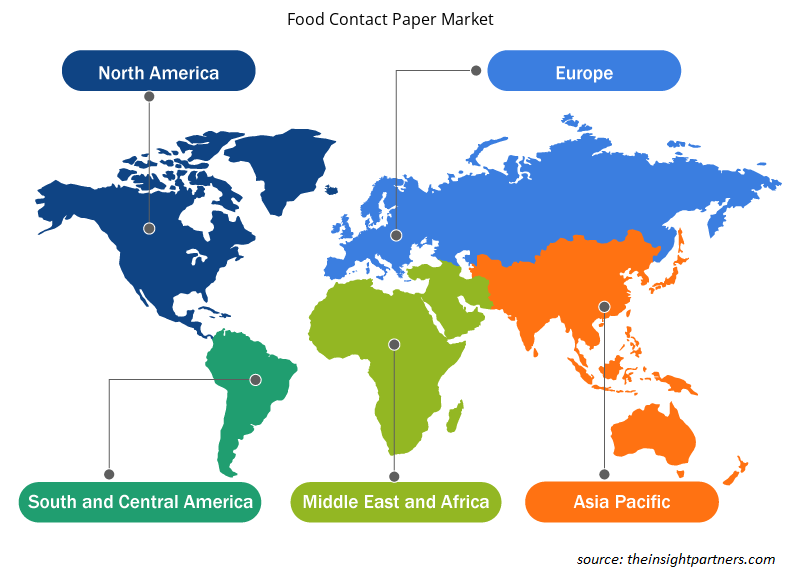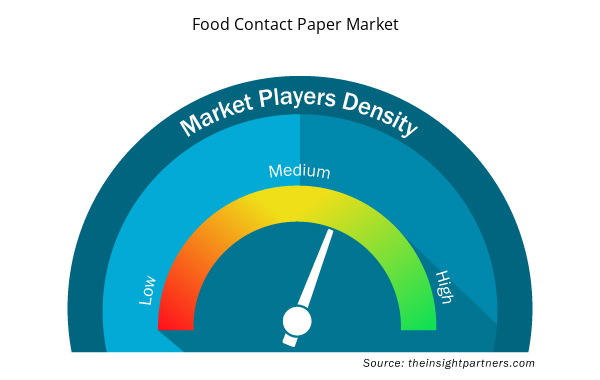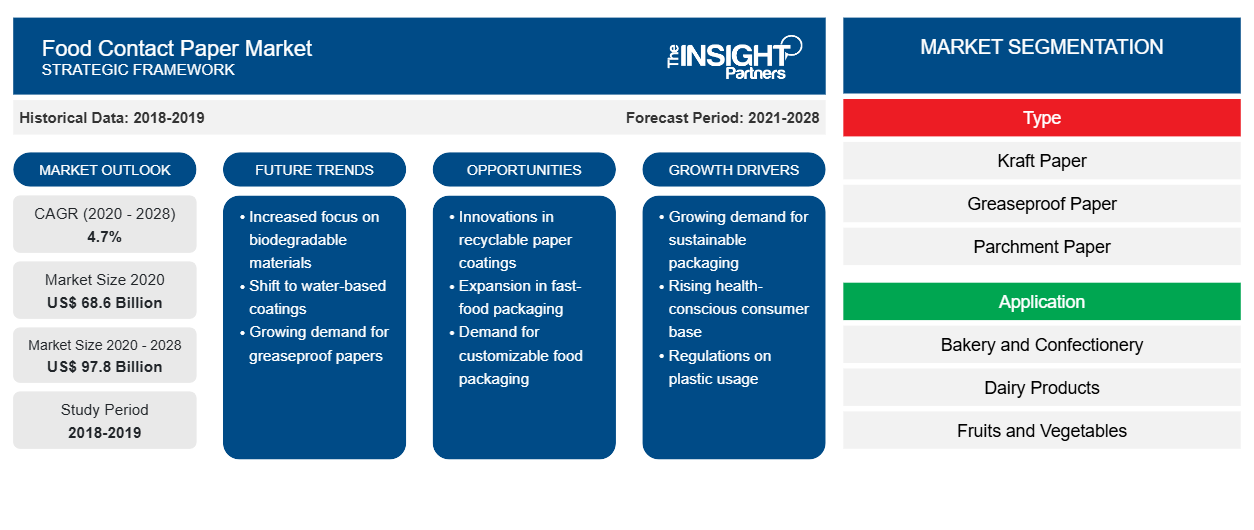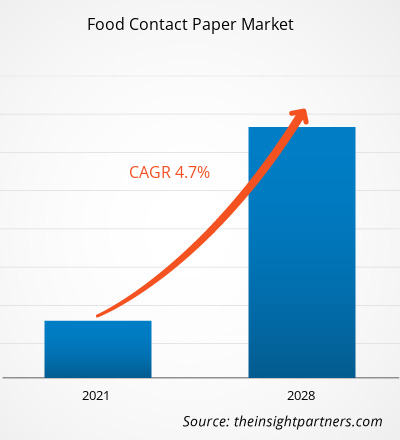Le marché du papier en contact avec les aliments était évalué à 68,6 milliards de dollars américains en 2020 et devrait atteindre 97,8 milliards de dollars américains d'ici 2028 ; il devrait croître à un TCAC de 4,7 % de 2021 à 2028.
Les papiers destinés au contact alimentaire sont utilisés comme matériaux d'emballage primaires pour divers produits alimentaires, tels que les produits de boulangerie, les confiseries, la viande, les snacks et les produits de la minoterie. Ces papiers constituent une alternative durable à de nombreux autres matériaux d'emballage alimentaire, tels que le plastique et le verre. Les initiatives croissantes des entreprises visant à réduire leur empreinte carbone influencent l'adoption du papier destiné au contact alimentaire dans le monde entier. L'augmentation de la demande d'emballages alimentaires durables et respectueux de l'environnement a également fait augmenter la demande d'emballages en papier alimentaire.
En 2020, la région Asie-Pacifique a dominé le marché mondial du papier en contact avec les aliments et devrait poursuivre sa domination au cours de la période de prévision. La croissance de l'industrie de la restauration dans les pays asiatiques, la sensibilisation croissante à l'environnement et l'augmentation des initiatives gouvernementales visant à interdire les emballages en plastique dans plusieurs pays asiatiques devraient accélérer la demande de solutions d'emballage écologiques et durables, ce qui stimulerait la croissance du marché du papier en contact avec les aliments en Asie-Pacifique.
Personnalisez ce rapport en fonction de vos besoins
Vous bénéficierez d'une personnalisation gratuite de n'importe quel rapport, y compris de certaines parties de ce rapport, d'une analyse au niveau des pays, d'un pack de données Excel, ainsi que de superbes offres et réductions pour les start-ups et les universités.
- Obtenez les principales tendances clés du marché de ce rapport.Cet échantillon GRATUIT comprendra une analyse de données, allant des tendances du marché aux estimations et prévisions.
De nombreuses industries, telles que l'industrie des produits chimiques et des matériaux, ont été confrontées à des défis sans précédent en raison de la pandémie de COVID-19. En raison de la pénurie de matières premières et de main-d'œuvre, de la fermeture des usines et d'autres difficultés opérationnelles dans le cadre des protocoles de sécurité COVID-19, les fabricants de produits d'emballage ont été confrontés à une contraction des ventes au cours des premiers mois de la pandémie. En outre, le changement de mode de vie des consommateurs et l'évolution de leurs habitudes alimentaires ont réduit la consommation d'aliments prêts à l'emploi et d'aliments d'extérieur en raison de la propagation du virus, ce qui a eu un impact négatif sur la demande de papiers en contact avec les aliments. Cependant, comme plusieurs pays lèvent le confinement avec des mesures de précaution appropriées, la demande de papiers en contact avec les aliments devrait reprendre. Le confinement ayant été imposé dans divers pays, le secteur du commerce électronique a connu une demande importante pour divers produits, tels que les aliments emballés et les produits d'épicerie, y compris les légumes et les fruits frais, en raison de la fermeture des magasins hors ligne, ce qui a favorisé l'utilisation de papiers en contact avec les aliments.
Informations sur le marché
Demande croissante de solutions d'emballage recyclables et biodégradables
Les emballages biodégradables et recyclables constituent une alternative intéressante aux emballages à usage unique, tant pour les consommateurs que pour les fabricants. Les emballages de restauration génèrent une quantité importante de déchets dans les décharges aux États-Unis. Selon un rapport publié par l'Agence américaine de protection de l'environnement, les déchets et les emballages alimentaires représentent la majorité des matériaux mis en décharge aux États-Unis. Les emballages en papier étant biodégradables, ils sont préférés aux emballages recyclables. L'utilisation d'emballages alimentaires recyclés augmente les risques de contamination, affectant ainsi potentiellement l'environnement et la santé humaine. Les initiatives croissantes des gouvernements du monde entier concernant l'utilisation de sacs en plastique à usage unique stimulent la demande de solutions d'emballage à la fois recyclables et durables, ce qui entraîne une demande accrue de papiers en contact avec les aliments.
Informations sur les types
En fonction du type, le marché du papier en contact avec les aliments est segmenté enLe papier kraft, le papier sulfurisé, le papier sulfurisé et autres. Le segment du papier kraft détenait la plus grande part de marché en 2020. Les papiers kraft naturels contiennent des fibres vierges pures, ce qui en fait une solution d'emballage idéale pour le contact alimentaire. Le papier est de plus en plus utilisé pour la fabrication de divers produits en papier destinés au contact alimentaire, tels que des sacs en papier, des sachets en papier, du papier d'emballage et des assiettes en papier. Le papier kraft naturel est également de plus en plus utilisé pour fabriquer des sacs d'épicerie pour les fruits et légumes frais en raison de sa grande résistance.
Mondi ; Westrock Company ; Georgia-Pacific LLC ; Twin River Paper Company ; UPM ; Ahlstrom-Munksjö ; GM Packaging (UK) Ltd ; Superiorpaper Pty Ltd. TopCare ; et KRPA Holding CZ figurent parmi les principaux acteurs opérant sur le marché du papier pour contact alimentaire. Les principaux acteurs du marché adoptent des stratégies telles que les fusions et acquisitions et les lancements de produits pour étendre leur présence géographique et leur base de consommateurs.
Rapports en vedette
- Tendances progressistes dans l'industrie du papier en contact avec les aliments pour aider les acteurs à développer des stratégies efficaces à long terme
- Stratégies de croissance commerciale adoptées par les entreprises pour assurer leur croissance sur les marchés développés et en développement
- Analyse quantitative du marché mondial du papier en contact avec les aliments de 2019 à 2028
- Estimation de la demande de papier en contact avec les aliments dans diverses industries
- Analyse de Porter pour illustrer l'efficacité des acheteurs et des fournisseurs opérant dans l'industrie pour prédire la croissance du marché
- Développements récents pour comprendre le scénario concurrentiel du marché et la demande de papier en contact avec les aliments
- Tendances et perspectives du marché associées aux facteurs qui stimulent et freinent la croissance du marché du papier en contact avec les aliments
- Compréhension des stratégies qui sous-tendent l'intérêt commercial à l'égard de la croissance du marché mondial du papier en contact avec les aliments, aidant au processus de prise de décision
- Taille du marché du verre flotté à différents nœuds du marché
- Aperçu détaillé et segmentation du marché mondial du papier pour contact alimentaire ainsi que de sa dynamique industrielle
- Taille du marché du papier pour contact alimentaire dans diverses régions avec des opportunités de croissance prometteuses
Aperçu régional du marché du papier pour contact alimentaire
Les tendances et facteurs régionaux influençant le marché du papier pour contact alimentaire tout au long de la période de prévision ont été expliqués en détail par les analystes d’Insight Partners. Cette section traite également des segments et de la géographie du marché du papier pour contact alimentaire en Amérique du Nord, en Europe, en Asie-Pacifique, au Moyen-Orient et en Afrique, ainsi qu’en Amérique du Sud et en Amérique centrale.

- Obtenez les données régionales spécifiques au marché du papier en contact avec les aliments
Portée du rapport sur le marché du papier en contact avec les aliments
| Attribut de rapport | Détails |
|---|---|
| Taille du marché en 2020 | 68,6 milliards de dollars américains |
| Taille du marché d'ici 2028 | 97,8 milliards de dollars américains |
| Taux de croissance annuel composé mondial (2020-2028) | 4,7% |
| Données historiques | 2018-2019 |
| Période de prévision | 2021-2028 |
| Segments couverts | Par type
|
| Régions et pays couverts | Amérique du Nord
|
| Leaders du marché et profils d'entreprises clés |
|
Densité des acteurs du marché du papier en contact avec les aliments : comprendre son impact sur la dynamique commerciale
Le marché du papier pour contact alimentaire connaît une croissance rapide, tirée par la demande croissante des utilisateurs finaux en raison de facteurs tels que l'évolution des préférences des consommateurs, les avancées technologiques et une plus grande sensibilisation aux avantages du produit. À mesure que la demande augmente, les entreprises élargissent leurs offres, innovent pour répondre aux besoins des consommateurs et capitalisent sur les tendances émergentes, ce qui alimente davantage la croissance du marché.
La densité des acteurs du marché fait référence à la répartition des entreprises ou des sociétés opérant sur un marché ou un secteur particulier. Elle indique le nombre de concurrents (acteurs du marché) présents sur un marché donné par rapport à sa taille ou à sa valeur marchande totale.
Les principales entreprises opérant sur le marché du papier en contact avec les aliments sont :
- Mondi
- Société Westrock
- Georgia-Pacific LLC
- Entreprise de papier Twin River
- UPM
Avis de non-responsabilité : les sociétés répertoriées ci-dessus ne sont pas classées dans un ordre particulier.

- Obtenez un aperçu des principaux acteurs du marché du papier pour contact alimentaire
Marché du papier en contact avec les aliments, par type
- Papier Kraft
- Papier sulfurisé
- Papier sulfurisé
- Autres
Marché du papier en contact avec les aliments, par application
- Boulangerie et Confiserie
- Produits laitiers
- Fruits et légumes
- Viande, poisson et volaille
- Autres
Profils d'entreprise
- Mondi
- Société Westrock
- Georgia-Pacific LLC
- Entreprise de papier Twin River
- UPM
- Ahlström-Munksjö
- GM Packaging (Royaume-Uni) Ltd
- Superiorpaper Pty Ltd
- Soins de qualité supérieure
- KRPA Holding CZ, comme
- Analyse historique (2 ans), année de base, prévision (7 ans) avec TCAC
- Analyse PEST et SWO
- Taille du marché Valeur / Volume - Mondial, Régional, Pays
- Industrie et paysage concurrentiel
- Ensemble de données Excel


- Underwater Connector Market
- Influenza Vaccines Market
- USB Device Market
- Non-Emergency Medical Transportation Market
- Machine Condition Monitoring Market
- Small Internal Combustion Engine Market
- Extracellular Matrix Market
- Advanced Planning and Scheduling Software Market
- Excimer & Femtosecond Ophthalmic Lasers Market
- Educational Furniture Market

Report Coverage
Revenue forecast, Company Analysis, Industry landscape, Growth factors, and Trends

Segment Covered
This text is related
to segments covered.

Regional Scope
North America, Europe, Asia Pacific, Middle East & Africa, South & Central America

Country Scope
This text is related
to country scope.
Questions fréquemment posées
Based on application, the global food contact paper market is segmented into bakery and confectionery, dairy products, fruits and vegetables, meat fish and poultry, and others. In 2020, the bakery and confectionery segment accounted for a significant revenue share. The food contact paper is being increasingly used in the bakery and confectionery sector which includes the usage of parchment paper in baking as it is heat-resistant and provides a non-stick surface to bake on. The common use of parchment paper is to eliminate the need for grease sheet pans and also allows a very rapid turnaround of batches of baked goods with minimal clean-up. Greaseproof paper is also an ideal solution for bakery items as it is able to withstand a wide range of environments, from hot oven to deep freezer & humidity.
On the basis of type, the greaseproof paper segment held the fastest CAGR in the food contact paper market for the forecast period. The paper is used for wrapping food items such as sandwiches, cheese, desserts, baked goods, and cold meats. The greaseproof paper will help in providing a grease-free method for transporting and handling oily foods. These papers are also recyclable as well as printable. The greaseproof paper is permeable to air and moisture, which makes it possible for the food inside the paper to breathe and steam and exhale excess moisture.
The fruit and vegetable segment is expected to grow at the fastest rate during the forecast period. There has been an increase use of kraft paper in various food contact paper packaging solutions for fruits and vegetables. It is being used as a vegetable box which is used for packaging and shipping of the vegetables and fruits as well as is used to produce embossed paper cushion pads for the packaging of vegetables and fresh fruit. Along with this, wax paper is also used for storing fruits and vegetables as the moisture retention capabilities of wax paper will keep the fruits and vegetables fresh for a longer period of time and will slow down their ripening and spoilage rate.
Kraft paper is basically a paper or paperboard which is being produced from the chemical pulp through kraft papers. The natural kraft papers have pure virgin fibers which makes it an ideal food contact packaging solution. Kraft paper is being increasingly used for manufacturing various food contact papers including paper bags, paper sacks, wrapping paper, and paper plates. Natural kraft paper is also being increasingly used as a grocery bag for fresh fruits and vegetables which is due to its high strength.
The major key players operating in the global food contact paper market include Mondi; Westrock Company; Georgia-Pacific LLC; Twin River Paper Company; UPM; Ahlstrom-Munksjö; GM Packaging (UK) Ltd; Superiorpaper Pty Ltd. TopCare; and KRPA Holding CZ, a.s and SK Hynix Inc.
The Asia Pacific dominated the global market. The region is expected to continue its dominance during the forecast period. The growing market penetration of the foodservice industry in recent years in the Asian countries is estimated to accelerate the food contact paper market growth in this region during the forecast period. Along with this, an increase in awareness about the environment is expected to result in increased demand for greener packaging solutions. Various initiatives taken by the government to ban plastic packaging in several Asian countries are also expected to accelerate the demand for eco-friendly and sustainable packaging solutions, which will increase the demand for food contact paper in the Asia Pacific. Along with this, the increasing presence of domestic and international players in the market has led to an increased focus of product quality and innovation, which will provide growth opportunities for the food contact paper market.
Trends and growth analysis reports related to Chemicals and Materials : READ MORE..
The List of Companies - Food Contact Paper Market
- Mondi
- Westrock Company
- Georgia-Pacific LLC
- Twin River Paper Company
- UPM
- Ahlstrom-Munksjö
- GM Packaging (UK) Ltd
- Superiorpaper Pty Ltd
- TopCare
- KRPA Holding CZ, a.s.
The Insight Partners performs research in 4 major stages: Data Collection & Secondary Research, Primary Research, Data Analysis and Data Triangulation & Final Review.
- Data Collection and Secondary Research:
As a market research and consulting firm operating from a decade, we have published and advised several client across the globe. First step for any study will start with an assessment of currently available data and insights from existing reports. Further, historical and current market information is collected from Investor Presentations, Annual Reports, SEC Filings, etc., and other information related to company’s performance and market positioning are gathered from Paid Databases (Factiva, Hoovers, and Reuters) and various other publications available in public domain.
Several associations trade associates, technical forums, institutes, societies and organization are accessed to gain technical as well as market related insights through their publications such as research papers, blogs and press releases related to the studies are referred to get cues about the market. Further, white papers, journals, magazines, and other news articles published in last 3 years are scrutinized and analyzed to understand the current market trends.
- Primary Research:
The primarily interview analysis comprise of data obtained from industry participants interview and answers to survey questions gathered by in-house primary team.
For primary research, interviews are conducted with industry experts/CEOs/Marketing Managers/VPs/Subject Matter Experts from both demand and supply side to get a 360-degree view of the market. The primary team conducts several interviews based on the complexity of the markets to understand the various market trends and dynamics which makes research more credible and precise.
A typical research interview fulfils the following functions:
- Provides first-hand information on the market size, market trends, growth trends, competitive landscape, and outlook
- Validates and strengthens in-house secondary research findings
- Develops the analysis team’s expertise and market understanding
Primary research involves email interactions and telephone interviews for each market, category, segment, and sub-segment across geographies. The participants who typically take part in such a process include, but are not limited to:
- Industry participants: VPs, business development managers, market intelligence managers and national sales managers
- Outside experts: Valuation experts, research analysts and key opinion leaders specializing in the electronics and semiconductor industry.
Below is the breakup of our primary respondents by company, designation, and region:

Once we receive the confirmation from primary research sources or primary respondents, we finalize the base year market estimation and forecast the data as per the macroeconomic and microeconomic factors assessed during data collection.
- Data Analysis:
Once data is validated through both secondary as well as primary respondents, we finalize the market estimations by hypothesis formulation and factor analysis at regional and country level.
- Macro-Economic Factor Analysis:
We analyse macroeconomic indicators such the gross domestic product (GDP), increase in the demand for goods and services across industries, technological advancement, regional economic growth, governmental policies, the influence of COVID-19, PEST analysis, and other aspects. This analysis aids in setting benchmarks for various nations/regions and approximating market splits. Additionally, the general trend of the aforementioned components aid in determining the market's development possibilities.
- Country Level Data:
Various factors that are especially aligned to the country are taken into account to determine the market size for a certain area and country, including the presence of vendors, such as headquarters and offices, the country's GDP, demand patterns, and industry growth. To comprehend the market dynamics for the nation, a number of growth variables, inhibitors, application areas, and current market trends are researched. The aforementioned elements aid in determining the country's overall market's growth potential.
- Company Profile:
The “Table of Contents” is formulated by listing and analyzing more than 25 - 30 companies operating in the market ecosystem across geographies. However, we profile only 10 companies as a standard practice in our syndicate reports. These 10 companies comprise leading, emerging, and regional players. Nonetheless, our analysis is not restricted to the 10 listed companies, we also analyze other companies present in the market to develop a holistic view and understand the prevailing trends. The “Company Profiles” section in the report covers key facts, business description, products & services, financial information, SWOT analysis, and key developments. The financial information presented is extracted from the annual reports and official documents of the publicly listed companies. Upon collecting the information for the sections of respective companies, we verify them via various primary sources and then compile the data in respective company profiles. The company level information helps us in deriving the base number as well as in forecasting the market size.
- Developing Base Number:
Aggregation of sales statistics (2020-2022) and macro-economic factor, and other secondary and primary research insights are utilized to arrive at base number and related market shares for 2022. The data gaps are identified in this step and relevant market data is analyzed, collected from paid primary interviews or databases. On finalizing the base year market size, forecasts are developed on the basis of macro-economic, industry and market growth factors and company level analysis.
- Data Triangulation and Final Review:
The market findings and base year market size calculations are validated from supply as well as demand side. Demand side validations are based on macro-economic factor analysis and benchmarks for respective regions and countries. In case of supply side validations, revenues of major companies are estimated (in case not available) based on industry benchmark, approximate number of employees, product portfolio, and primary interviews revenues are gathered. Further revenue from target product/service segment is assessed to avoid overshooting of market statistics. In case of heavy deviations between supply and demand side values, all thes steps are repeated to achieve synchronization.
We follow an iterative model, wherein we share our research findings with Subject Matter Experts (SME’s) and Key Opinion Leaders (KOLs) until consensus view of the market is not formulated – this model negates any drastic deviation in the opinions of experts. Only validated and universally acceptable research findings are quoted in our reports.
We have important check points that we use to validate our research findings – which we call – data triangulation, where we validate the information, we generate from secondary sources with primary interviews and then we re-validate with our internal data bases and Subject matter experts. This comprehensive model enables us to deliver high quality, reliable data in shortest possible time.


 Obtenez un échantillon gratuit pour ce rapport
Obtenez un échantillon gratuit pour ce rapport